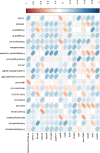Effect of folpet on hypoglycaemia, intestinal microbiota, and drug resistance genes in mice
- PMID: 39789436
- PMCID: PMC11715183
- DOI: 10.1186/s12866-024-03725-3
Effect of folpet on hypoglycaemia, intestinal microbiota, and drug resistance genes in mice
Abstract
Background: Folpet is a nonspecific sulfonamide fungicide widely used to protect crops from mildew. However, the in vivo effects of folpet on glucose metabolism homeostasis, gut microbiota, and abundance of drug resistance genes remain unknown. The purpose of this study was to assess the effects of the pesticide, folpet, on glucose metabolism homeostasis, and folpet-induced changes in the intestinal microbiota and resistance genes in mice.
Methods: Mice were orally administered folpet at 0, 1, 10, and 100 mg/kg body weight/day for 5 weeks. Blood sugar levels in mice were measured after 5 weeks of folpet administration. Metagenomic sequencing and drug resistance gene analyses were performed to explore changes in the abundance of gut microbiota members and drug resistance genes in mice after folpet administration. Correlation analysis was performed using metabolomics to explore the relationship between intestinal microbiota, drug resistance genes, and glucose metabolism.
Results: Mice in the folpet group had significantly lower blood glucose levels than those in the control group. The abundance of Atopobium, Libanicoccus, Collinsella, and Parabacteroides in the intestinal microbiota of folpet-treated mice was significantly higher than that in the control group. However, the abundance of Mailhella, Bilophila, Roseburia, and Bacteroides were reduced in folpet-treated mice. Compared with the control group, the abundance of APH6-Ic and AAC6-Ie-APH2-Ia resistance genes in mice treated with folpet significantly increased. The abundance of tetQ, ermE, and BahA resistance genes was significantly reduced after folpet treatment.
Conclusions: Folpet is associated with changes in the abundance of gut microbiota in mice and may also affect the abundance of drug-resistance genes and the regulation of blood glucose levels.
Keywords: Folpet; Intestinal microbiota; Metabolome; Resistance genes.
© 2024. The Author(s).
Conflict of interest statement
Declarations. Ethical approval: All animal experiments were approved by the TopBiotech Animal Care and Use Committee (TOP-IACUC-2021-0082) and were conducted in accordance with the ARRIVE guidelines. Consent for publication: Not applicable. Competing interests: The authors declare no competing interests.
Figures



Similar articles
-
16S rRNA Sequencing and Metagenomics Study of Gut Microbiota: Implications of BDB on Type 2 Diabetes Mellitus.Mar Drugs. 2020 Sep 17;18(9):469. doi: 10.3390/md18090469. Mar Drugs. 2020. PMID: 32957565 Free PMC article.
-
Honeybee Exposure to Veterinary Drugs: How Is the Gut Microbiota Affected?Microbiol Spectr. 2021 Sep 3;9(1):e0017621. doi: 10.1128/Spectrum.00176-21. Epub 2021 Aug 11. Microbiol Spectr. 2021. PMID: 34378962 Free PMC article.
-
Shenqi compound ameliorates type-2 diabetes mellitus by modulating the gut microbiota and metabolites.J Chromatogr B Analyt Technol Biomed Life Sci. 2022 Apr 1;1194:123189. doi: 10.1016/j.jchromb.2022.123189. Epub 2022 Feb 24. J Chromatogr B Analyt Technol Biomed Life Sci. 2022. PMID: 35219959
-
A specific gut microbiota and metabolomic profiles shifts related to antidiabetic action: The similar and complementary antidiabetic properties of type 3 resistant starch from Canna edulis and metformin.Pharmacol Res. 2020 Sep;159:104985. doi: 10.1016/j.phrs.2020.104985. Epub 2020 Jun 3. Pharmacol Res. 2020. PMID: 32504839
-
Quercetin Alleviates Insulin Resistance and Repairs Intestinal Barrier in db/db Mice by Modulating Gut Microbiota.Nutrients. 2024 Jun 14;16(12):1870. doi: 10.3390/nu16121870. Nutrients. 2024. PMID: 38931226 Free PMC article.
References
-
- Sun H, Zhang X, Zuo W, Dai Z, Zhou L, Luo F, et al. Concentrations, generation and risk characterization of phthalimide in tea-derived from folpet or not? Sci Total Environ. 2022;852:158194. - PubMed
-
- Huertas-Perez JF, Ernest M, Varela J, Badoud F. Quantification of folpet and phthalimide in food by gas chromatography and mass spectrometry: overcoming potential analytical artefacts. Food Chem. 2018;260:213–20. - PubMed
-
- Poet TS, Kousba AA, Dennison SL, Timchalk C. Physiologically based pharmacokinetic/pharmacodynamic model for the organophosphorus pesticide diazinon. Neurotoxicology. 2004;25:1013–30. - PubMed
-
- Jankowska M, Lozowicka B, Kaczynski P. Comprehensive toxicological study over 160 processing factors of pesticides in selected fruit and vegetables after water, mechanical and thermal processing treatments and their application to human health risk assessment. Sci Total Environ. 2019;652:1156–67. - PubMed
-
- Park S, Yun BH, Bae H, Lim W, Song G. Reproductive toxicity of folpet through deregulation of calcium homeostasis in porcine trophectoderm and luminal epithelial cells during early pregnancy. Pestic Biochem Physiol. 2021;179:104974. - PubMed
MeSH terms
Substances
Grants and funding
LinkOut - more resources
Full Text Sources
Medical

